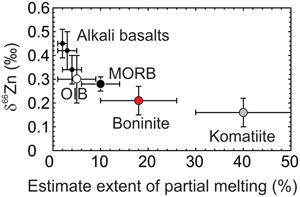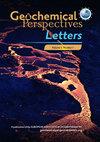A partial melting control on the Zn isotope composition of basalts
IF 3.7
1区 地球科学
Q1 GEOCHEMISTRY & GEOPHYSICS
引用次数: 9
Abstract
Basaltic partial melts are produced in a range of tectonic settings, including fluid-assisted melting above subduction zones, decompression melting at ridges and thermally driven melting above mantle plumes. To examine the role of partial melting on Zn, isotope and abundance data are reported for modern large-degree partial melts of the mantle represented by 22 mid-ocean ridge basalts (MORB) from three ocean basins and the first data for boninites. Boninites have some of the lowest Zn abundances of all terrestrial basalts and Zn isotope compositions ( δ 66 Zn = þ 0.21 ± 0.06 ‰ ), generally lighter than for MORB ( δ 66 Zn = þ 0.28 ± 0.06 ‰ ). Accounting for partial melting, komatiites, boninites and MORB derive from mantle sources with δ 66 Zn of ∼ 0.16 ± 0.06 ‰ . Lower-degree partial melts, such as alkali basalts, can have higher δ 66 Zn, with up to ∼ 0.4 ‰ variation possible from partial melting of distinct peridotite mantle sources. Partial melting of fertile lherzolitic and depleted harzburgitic mantle sources can generate significant Zn isotope variability and should be evaluated prior to ascribing crustal, enriched or lithological components to mantle reservoirs from Zn compositions of planetary basalts.

玄武岩锌同位素组成的部分熔融控制
玄武岩部分熔体是在一系列构造环境中产生的,包括俯冲带上方的流体辅助熔融、山脊处的减压熔融和地幔柱上方的热驱动熔融。为了研究部分熔融对锌的作用,报道了以来自三个海盆的22个中洋脊玄武岩(MORB)为代表的地幔现代大程度部分熔融的同位素和丰度数据,以及首次获得的玻碳岩数据。在所有陆地玄武岩和锌同位素组成中,Boninite具有最低的锌丰度(δ66Zn=þ0.21±0.06‰),通常比MORB(δ66Zn=\254\0.28±0.06%‰)轻。考虑到部分熔融,Komatiite、Boninite和MORB来源于地幔源,δ66Zn为~0.16±0.06‰。较低程度的部分熔融,如碱性玄武岩,可能具有较高的δ66Zn,不同橄榄岩地幔源的部分熔融可能产生高达-0.4‰的变化。肥沃的二辉橄榄岩和贫化的方辉橄榄岩地幔源的部分熔融会产生显著的锌同位素变化,在将地壳、富集或岩性成分归因于行星玄武岩的锌成分的地幔储层之前,应进行评估。
本文章由计算机程序翻译,如有差异,请以英文原文为准。
求助全文
约1分钟内获得全文
求助全文
来源期刊

Geochemical Perspectives Letters
Earth and Planetary Sciences-Geochemistry and Petrology
CiteScore
7.00
自引率
2.00%
发文量
42
审稿时长
15 weeks
期刊介绍:
Geochemical Perspectives Letters is an open access, internationally peer-reviewed journal of the European Association of Geochemistry (EAG) that publishes short, highest-quality articles spanning geochemical sciences. The journal aims at rapid publication of the most novel research in geochemistry with a focus on outstanding quality, international importance, originality, and stimulating new developments across the vast array of geochemical disciplines.
 求助内容:
求助内容: 应助结果提醒方式:
应助结果提醒方式:


